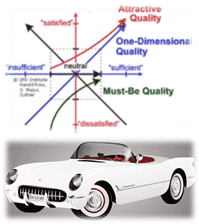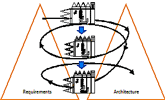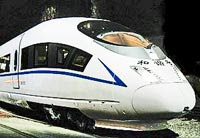The previous post (
Election-earing: how QFD helped a candidate truly hear the Voice of the Constituent) previewed the first-of-its-kind political campaign case study. In addition, these exciting presentations are planned for
The 24th Symposium on QFD, November 2, 2012 in St. Augustine, Florida.
The
transactions of this symposium will become available to public in May 2013, but the most privileged content is often shared with the symposium audience only. In addition, the 2012 symposium includes a mini tutorial on
Hoshin Kanri (Policy Management).
Come join us to learn and network. This will be also a good chance to get your QFD questions answered and receive tips on how to apply these tools in your project.
Registration is still open.
. . . . . . . . . . . . . . . . . . . .
"Going to the Gemba: Number Two with a Bullet"
The first generation of Chinese bullet trains was marred with design flaws that manifested in the catastrophic July 2011 accident which killed at least 40 people and injured more than 200 (NYTimes.com, Dec. 28, 2011). For the second generation hi-speed trains, Tangshan Railway Vehicle Company decided to try QFD to address the previous deficiencies.
The symposium presentation will share the traditional QFD approach and tools used in this project, as well as the unique gemba story in a country where the central government and Chinese Ministry of Railways believe that they speak for everyone and represent the voice of the customers.
Speaker: Jack B. ReVelle, Ph.D., ReVelle Solutions, LLC (USA)
"Change Fix Model"
Some of the issues that add complication to IT projects include volatility of customer requirements and assessing risks involving changes. The Change Fix Model aims to improve agility of the estimation by using lean and QFD tools, enabling assessment of the impact of a change into the entire software lifecycle, starting with a regression model for establishing the relationship between impact of change and additional effort for implementing the change.
Using a CTQ drill down tree, which is one of the mechanisms to implement QFD, the paper is the first of its kind to measure the impact of a change by using a regression model. This will be presented by using a case of a major communications player.
Speaker: Karthik Jegannathan, Cognizant Technologies Solutions (India/USA)
"Repertory Grid – Potential for Requirements Management in the Quality Function Deployment - An Example of the German Smartphone Market"
This research by German scholars proposes integration of cognitive psychology science, the Repertory Grid Technique (RGT), into QFD. In evaluating quality/performance of a product/service, customers follow unconscious personal perceptions, besides consideration of physical properties such as size, color, functions, etc. It is these unconsciously perceived characteristics that play an important role in the decision making process.
Repertory Grid Technique is based on the Personal Construct Theory, a constructivist theory that contends that people experience, organize, and describe their environment in terms of cognitive personal concepts that can be distilled into bipolar verbal labels. From its initial application in psychological diagnosis, the method has evolved to a set of general guidelines used in a wide variety of application domains, including environmental studies, education, healthcare, business, and it can be useful in identification of customer requirements in QFD analysis. The symposium presentation will use a case of German smartphone market to introduce RGT and show how it can be used in QFD analysis.
Speaker: Philipp Tursch, Chair Quality Management, Cottbus University of Technology (Germany)
"Elementary QFD: Using QFD to Assess and Evaluate the Learning Environment of a Private School Library and to Systematically Engage an ISACS Review"
A Modern Blitz QFD
® application in a non-traditional customer/product model – a school. Emerson School, a private school in Ann Arbor, Michigan, is in the midst of undergoing a review by The Independent Schools Association of the Central States (ISACS). The project goal was to identify key customers and translate their Voice of Customer as well as ISACS criteria into true customer needs.
Often organizations act on a situation without fully determining the true needs of stakeholders that would reveal the important context or unstated factor, leading to inadequate solutions or even exacerbated situations. This occurred several years ago. QFD gemba study revealed the largest and unexpected hindrances to the current learning environment in the library media center. These observations and customer verbatims were translated into true needs and fully ordered using paired comparisons in the
Analytic Hierarchy Process. Finally, the highest ranking needs were evaluated on a systematic level, addressing potential causes for concern such as difficulties of implementation, perception of teachers and students, as well as resources like cost, time and effort.
Speaker: Ken Mazur, QFD Black Belt®, Japan Business Consultants, Ltd., USA
"Implementing Quality Function Deployment to Improve Service Quality and Customer Satisfaction: A Three Stages Empirical Approach in Jordanian Mobile Telecommunication"
The aim of this research is to develops a conceptual model that integrates the SERVQUAL Gap model and QFD to help telecom companies in Jordan explore service quality shortfalls and improve customer satisfaction. The first stage involved designing, administering and analyzing the SERVQUAL framework questionnaire.
The study population comprises all Jordanian mobile telecommunications companies (Zain, Orange, and Umniah) located in Amman, the capital of Jordan. There is a gap between expectations and experience in all service quality dimensions. QFD model will be used to close these gaps.
Speaker: Tasneem Alfalah, Glasgow Caledonian University (UK)
"QFD and Politics (A Sure Way To Start An Argument)"
First of its kind, this paper reports the use of Modern Blitz QFD
® tools in an actual political campaign for a Florida county judgeship. The primary focus was to understand how to: 1) select target segments; 2) use the voice (top needs) of the target segment customers to develop the strategy; 3) create messaging; and 4) deploy the messaging to the targeted segment.
This application uniquely deploys downstream using the Voice of Constituents data to make strategic and operational decisions. For example, what sort of true “customer needs” can be identified from this verbatim voice of voters — “what do you think about the Chick-fil-A case?” Read more on this paper in the
previous post...
Speaker: Carey Hepler, QFD Black Belt®, Solantic Urgent Care (USA)
Skills Building Exercise: Hoshin Kanri mini tutorial
Hoshin Kanri is a systematic quality approach to planning, executing, auditing, and managing corporate vision and business strategy. It is a company-wide strategic management system that uses common QFD tools to visually indicate the relationships between executive-level targets and the means to achieve them, and those of direct reports. In this mini workshop, attendees will be introduced to the basic concept and application of how Hoshin Kanri works through an easy-to-follow example and hands-on exercise.
Instructor: Glenn Mazur, QFD Red Belt®, QFD Institute
Events Schedule (PDF)
How to attend...







































